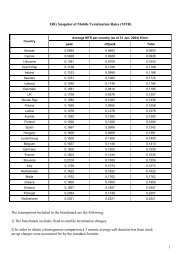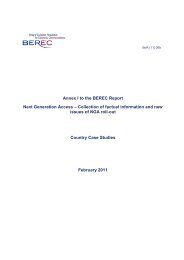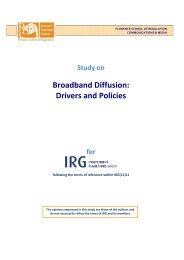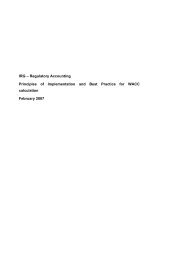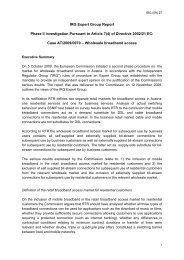16 Rev2b NGA Opinion Supplementary doc - IRG
16 Rev2b NGA Opinion Supplementary doc - IRG
16 Rev2b NGA Opinion Supplementary doc - IRG
You also want an ePaper? Increase the reach of your titles
YUMPU automatically turns print PDFs into web optimized ePapers that Google loves.
ERG (07) <strong>16</strong>rev2b <strong>NGA</strong> <strong>Opinion</strong> <strong>Supplementary</strong> Doc 3 / 69<br />
Question Chapter 1: Do you agree with the general approach?<br />
Consultation Comments<br />
Very broadly there were slightly more comments that supported the approach of the ERG<br />
than comments criticizing it. Whereas competitors welcomed the paper, mainly the incumbents<br />
hold the opposite view.<br />
Supportive: Arcor, BREKO, C&W, Comptel, ECTA, EuroISPA, Fastweb, Ifkom, ONI, Platform<br />
Telecom Operators & Service Providers, QSC, Riegelmayer, Silver Server, Tele2, WIND<br />
These supportive statements range from stating that the ERG took the “right approach” (Sonaecom),<br />
to “potential barriers were found out perfectly” (Silver Server), or to “congratulating<br />
for tackling the regulatory challenges” (Comptel). Based on a “correct” description of the<br />
network and the required equipment the solutions and conclusions proposed by the ERG are<br />
considered “adequately fitting the problems” (Arcor). Others express agreement to the proposed<br />
revisions of the Recommendation on Relevant Markets (EuroISPA) or “largely share”<br />
(WIND), or are even “unanimously support” (QSC) the conclusions. More generally, one<br />
comment speaks of a “high quality Consultation Document” (Tele2).<br />
Some comments see “proper ex-ante regulation of access condition to incumbents’ <strong>NGA</strong><br />
network important for maintaining a level-playing field (ONI, similar e.g. WIND).<br />
According to the comment of a stakeholder group the current Regulatory Framework is “fundamentally<br />
sound” and the fundamental principles remain valid in an <strong>NGA</strong> context. However,<br />
a need for focus on enforcement and consistency in application throughout the EU is called<br />
for (EuroISPA).<br />
It seems remarkable that even an incumbent was rather consenting when answering this<br />
question (TDC). It welcomes a technology neutral approach to the analysis of possible bottlenecks<br />
in access infrastructure, therefore considering the inclusion of fibre as proposed by<br />
the ERG appropriate (see ad 4.2.1 below).<br />
Critical: BT, Colt, DTAG, ETNO, ETP, FT, OTE, KPN, PT, TI, Telefónica<br />
The critics argue that the ERG “fails to ask whether regulation is necessary” (DTAG, similar<br />
BT) or miss further discussion on when remedies are appropriate (Telefónica). They consider<br />
the <strong>doc</strong>ument to be based on the assumption that current unbundling obligations of<br />
incumbent operators need to be mirrored in the NGN situation” (KPN, similar other incumbents<br />
and ETNO). One comment evaluates the approach as sending the “wrong message”<br />
that all obligations will be applied making the <strong>doc</strong>ument a “general overview of all the possible<br />
regulatory measures that NRAs are working on in different Member States” (Telefónica).<br />
More specifically, a comment refers to the difficulties of implementing some of the proposed<br />
remedies and considers a cost/benefit analysis for new measures appropriate (Telefónica).<br />
The critics stress that <strong>NGA</strong> networks are new and differ largely from legacy networks which<br />
“cannot be regulated as legacy networks (TI). Thus, the starting point for the regulatory<br />
analysis should be a “hands-off” approach to avoid such mechanical transition of measures<br />
to NGNs (Telefónica). Such new investments require a regulatory focus on equal conditions<br />
for investment by reducing entry barriers and a technologically neutral view of market development.<br />
According to one comment, only the passive infrastructure is not replicable. Therefore, the<br />
regulatory focus should be on passive (e.g. ducts, poles) rather than active infrastructure<br />
(Alcatel-Lucent).



